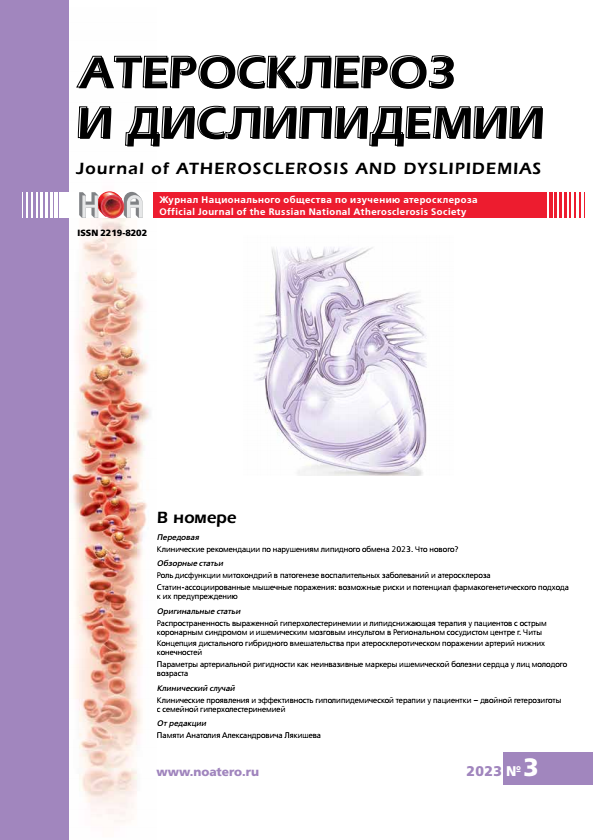The hybrid surgery concepts for atherosclerotic lesions of lower limb arteries
DOI:
https://doi.org/10.34687/2219-8202.JAD.2023.03.0005Abstract
Abstract. The study assessed the outcome of hybrid interventions done in patients with long chronic total occlusions (CTO) of the superficial femoral artery (SFA), patent proximal popliteal artery and extensive crural runoff disease. A series of conventional femoral tibial bypasses was used as historic control.
Aim. To improve the results of lower limb revascularization for extended SFA occlusion combined with tibial artery lesions.
Methods. The study included patients with CLTI (CHD 4), with a long (>20 cm) occlusion of the femoral-popliteal segment arteries and a severe lesion of the outflow channels. 1st group of patients (n-40, age 68.9 7.9, of which 75.0% are men) performed hybrid interventions (autologus femoral-popliteal bypass with endovascular reversal correction of the pathway), 2nd (n-35, age 64.17.2 years; 80.0% of men) - autologus femoral-tibial bypass (FTB).
Results. The incidence of angiosomal revascularization in the distal hybrid (DH) and FTB groups was 90.0% and 69.2%, respectively. The groups did not differ in the incidence of perioperative complications and postoperative bed days. After 1 year, the DH and FTB groups did not differ in terms of overall survival (87.1% and 82.5%), limb preservation (73.7% and 74.9%), freedom from repeat revascularizations (96.0% and 82.0%), and the rate of trophic defect healing (88.2% and 80.0%). The primary patency of the shunt after 1 year was 80.8% in the DH group and 53.2% in the FTB group.
Conclusion. The most effective, modern and high to complete rehabilitation is hybrid method of CLTI revascularization. Pathophysiologically high efficiency of the technique is determined by multimodal approach with cumulation of advantages of open and endovascular methods.
Downloads
References
Walden R, Adar R, Rubinstein ZJ, et al. Distribution and symmetry of arteriosclerotic lesions of the lower extremities: an arteriographic study of 200 limbs. Cardiovasc Intervent Radiol. 1985;8(4):180-2. J Vasc Surg. 2010;51(5 Suppl):32S-42S.
Narula N, Dannenberg AJ, Olin JW, et al. Pathology of peripheral artery disease in patients with critical limb ischemia. J Am Coll Cardiol. 2018;72(18):2152-2163.
Chung J, Modrall JG, Knowles M, et al. Arteriographic patterns of atherosclerosis and the association between diabetes mellitus and ethnicity in chronic critical limb ischemia. Ann Vasc Surg. 2017;40:198-205.
Rueda CA, Nehler MR, Perry DJ, et al. Patterns of artery disease in 450 patients undergoing revascularization for critical limb ischemia: implications for clinical trial design. J Vasc Surg. 2008;47(5):995-9.
Bradbury AW, Adam DJ, Bell J, et al. Bypass versus Angioplasty in Severe Ischaemia of the Leg (BASIL) trial: A description of the severity and extent of disease using the Bollinger angiogram scoring method and the TransAtlantic Inter-Society Consensus II classification. J Vasc Surg. 2010;51(5 Suppl):32S-42S.
Blair JM, Gewertz BL, Moosa H, et al. Percutaneous transluminal angioplasty versus surgery for limb-threatening ischemia. J Vasc Surg. 1989;9(5):698-703.
Palena LM, Diaz-Sandoval LJ, Sultato E, et al. Feasibility and 1-year outcomes of subintimal revascularization with Supera® stenting of long femoropopliteal occlusions in critical limb ischemia: the “Supersub” study. Catheter Cardiovasc Interv. 2017;89(5):910-920.
Davies MG, Saad WE, Peden EK, et al. Impact of runoff on superficial femoral artery endoluminal interventions for rest pain and tissue loss. J Vasc Surg. 2008;48(3):619-25.
Ah Chong AK, Tan CB, Wong MW, et al. Bypass surgery or percutaneous transluminal angioplasty to treat critical lower limb ischaemia due to infrainguinal arterial occlusive disease? Hong Kong Med J. 2009;15(4):249-54.
Moxey PW, Hofman D, Hinchliffe RJ, et al. Trends and outcomes after surgical lower limb revascularization in England. Br J Surg. 2011;98(10):1373-82.
Romiti M, Albers M, Brochado-Neto FC, et al. Meta-analysis of infrapopliteal angioplasty for chronic critical limb ischemia. J Vasc Surg. 2008;47(5):975-981.
Cotroneo AR, Iezzi R, Marano G et al: Hybrid therapy in patients with complex peripheral multifocal steno-obstructive vascular disease: two-year results. Cardiovasc Intervent Radiol 2007;30:355–361.
Zhou M, Huang D, Liu C, et al. Comparison of hybrid procedure and open surgical revascularization for multilevel infrainguinal arterial occlusive disease. Clin Interv Aging. 2014;9:1595-603.
Conte MS, Bradbury AW, Kolh P, et al. Global vascular guidelines on the management of chronic limb-threatening ischemia. Eur J Vasc Endovasc Surg. 2019;58(1S):S1-S109.
Toursarkissian B, D’Ayala M, Stefanidis D, et al. Angiographic scoring of vascular occlusive disease in the diabetic foot: relevance to bypass graft patency and limb salvage. J Vasc Surg. 2002;35(3):494-500.
Gruss JD, Heimer W. Results of femoropopliteal and femorotibial greater saphenous vein in situ bypass. Life table analysis. Int Angiol. 1992;11(2):94-105.
Heimer W, Uy J, Geissler C, et al. Femoropopliteal and femorotibial greater saphenous vein “in situ” reconstructions in non selected patients. Life table analysis. J Cardiovasc Surg (Torino). 1993;34(4):303-5.
Iida O, Takahara M, Soga Y, et al. Impact of angiosome-oriented revascularization on clinical outcomes in critical limb ischemia patients without concurrent wound infection and diabetes. J Endovasc Ther. 2014;21(5):607-15.
Alexandrescu VA, Brochier S, Limgba A, et al. Healing of diabetic neuroischemic foot wounds with vs without wound-targeted revascularization: preliminary observations from an 8-year prospective dual-center registry. J Endovasc Ther. 2020;27(1):20-30.
Mannick JA, Jackson BT, Coffman JD, et al. Success of bypass vein grafts in patients with isolated popliteal artery segments. Surgery. 1967;61(1):17-25.
Downloads
Published
How to Cite
Issue
Section
License
Copyright (c) 2023 A. A. Кучай, А. Н. Липин , П. С. Курьянов, Н. Н. Груздев, К. А. Атмадзас, Н. Р. Карелина , Л. Ю. Артюх

This work is licensed under a Creative Commons Attribution 4.0 International License.























